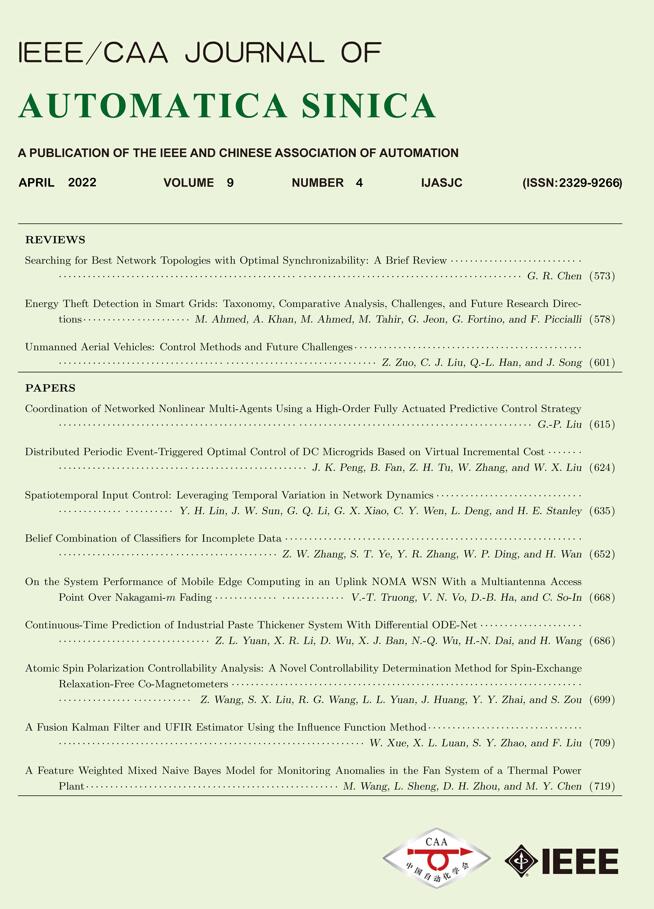 Volume 9
Issue 4
Volume 9
Issue 4
IEEE/CAA Journal of Automatica Sinica
| Citation: | Y. H. Lin, J. W. Sun, G. Q. Li, G. X. Xiao, C. Y. Wen, L. Deng, and H. E. Stanley, “Spatiotemporal input control: Leveraging temporal variation in network dynamics,” IEEE/CAA J. Autom. Sinica, vol. 9, no. 4, pp. 635–651, Apr. 2022. doi: 10.1109/JAS.2022.105455 |

| [1] |
U. N. Raghavan, R. Albert, and S. Kumara, “Near linear time algorithm to detect community structures in large-scale networks, ” Phys. Rev. E, vol. 76, p. 036106, Sep. 2007.
|
| [2] |
D. Kempe, J. Kleinberg, and É. Tardos, “Maximizing the spread of influence through a social network,” in Proc. 10th ACM SIGKDD Int. Conf. Knowledge Discovery and Data Mining, New York, USA, 2003, pp. 137–146.
|
| [3] |
M. J. Keeling and P. Rohani, Modeling Infectious Diseases in Humans and Animals. Princeton, USA: Princeton University Press, 2008.
|
| [4] |
O. Diekmann, H. Heesterbeek, and T. Britton, Mathematical Tools for Understanding Infectious Disease Dynamics. Princeton, USA: Princeton University Press, 2012
|
| [5] |
H. W. Hethcote, “The mathematics of infectious diseases,” SIAM Rev., vol. 42, no. 4, pp. 599–653, Dec. 2000. doi: 10.1137/S0036144500371907
|
| [6] |
G. Adomavicius and A. Tuzhilin, “Toward the next generation of recommender systems: A survey of the state-of-the-art and possible extensions,” IEEE Trans. Knowl. Data Eng., vol. 17, no. 6, pp. 734–749, Jun. 2005. doi: 10.1109/TKDE.2005.99
|
| [7] |
M. Girvan and M. E. J. Newman, “Community structure in social and biological networks,” Proc. Natl. Acad. Sci. USA, vol. 99, no. 12, pp. 7821–7826, Jun. 2002. doi: 10.1073/pnas.122653799
|
| [8] |
G. Cimini, T. Squartini, F. Saracco, D. Garlaschelli, A. Gabrielli, and G. Caldarelli, “The statistical physics of real-world networks,” Nat. Rev. Phys., vol. 1, no. 1, pp. 58–71, Jan. 2019. doi: 10.1038/s42254-018-0002-6
|
| [9] |
J. P. Onnela, J. Saramäki, J. Hyvönen, G. Szabó, D. Lazer, K. Kaski, J. Kertész, and A. L. Barabási, “Structure and tie strengths in mobile communication networks,” Proc. Natl. Acad. Sci. USA, vol. 104, no. 18, pp. 7332–7336, May 2007. doi: 10.1073/pnas.0610245104
|
| [10] |
G. A. Pagani and M. Aiello, “The power grid as a complex network: A survey,” Phys. A:Stat. Mechan. its Appl., vol. 392, no. 11, pp. 2688–2700, Jun. 2013. doi: 10.1016/j.physa.2013.01.023
|
| [11] |
S. Bansal, B. T. Grenfell, and L. A. Meyers, “When individual behaviour matters: Homogeneous and network models in epidemiology,” J. Roy. Soc. Interface, vol. 4, no. 16, pp. 879–891, Oct. 2007. doi: 10.1098/rsif.2007.1100
|
| [12] |
G. Yan, J. Ren, Y. C. Lai, C. H. Lai, and B. W. Li, “Controlling complex networks: How much energy is needed?” Phys. Rev. Lett., vol. 108, no. 21, p. 218703, May 2012.
|
| [13] |
J. Ruths and D. Ruths, “Control profiles of complex networks,” Science, vol. 343, no. 6177, pp. 1373–1376, Mar. 2014. doi: 10.1126/science.1242063
|
| [14] |
Y. Y. Liu and A. L. Barabási, “Control principles of complex systems, ” Rev. Mod. Phys., vol. 88, no. 3, p. 035006, Sept. 2016.
|
| [15] |
R. Rajkumar, I. Lee, L. Sha, and J. Stankovic, “Cyber-physical systems: The next computing revolution, ” in Proc. Design Automation Conf., Anaheim, USA, 2010, pp. 731–736.
|
| [16] |
A. E. Motter, S. A. Myers, M. Anghel, and T. Nishikawa, “Spontaneous synchrony in power-grid networks,” Nat. Phys., vol. 9, no. 3, pp. 191–197, Feb. 2013. doi: 10.1038/nphys2535
|
| [17] |
D. Del Vecchio, A. J. Dy, and Y. L. Qian, “Control theory meets synthetic biology, ” J. Roy. Soc. Interface, vol. 13, no. 120, p. 20160380, Jul. 2016.
|
| [18] |
R. D$’$Andrea and G. E. Dullerud, “Distributed control design for spatially interconnected systems,” IEEE Trans. Automatic Control, vol. 48, no. 9, pp. 1478–1495, Sept. 2003. doi: 10.1109/TAC.2003.816954
|
| [19] |
G. Yan, G. Tsekenis, B. Barzel, J. J. Slotine, Y. Y. Liu, and A. L. Barabási, “Spectrum of controlling and observing complex networks,” Nat. Phys., vol. 11, no. 9, pp. 779–786, Aug. 2015. doi: 10.1038/nphys3422
|
| [20] |
J. Sun and A. E. Motter, “Controllability transition and nonlocality in network control, ” Phys. Rev. Lett., vol. 110, no. 20, p. 208701, May 2013.
|
| [21] |
P. Holme and J. Saramaki, “Temporal networks,” Phys. Rep., vol. 519, no. 3, pp. 97–125, Oct. 2012. doi: 10.1016/j.physrep.2012.03.001
|
| [22] |
P. Holme, “Modern temporal network theory: A colloquium,” Eur. Phys. J. B, vol. 88, no. 9, Article No. 234, Sept. 2015. doi: 10.1140/epjb/e2015-60657-4
|
| [23] |
R. K. Pan and J. Saramäki, “Path lengths, correlations, and centrality in temporal networks, ” Phys. Rev. E, vol. 84, no. 1, p. 016105, Jun. 2011.
|
| [24] |
B. Y. Hou, X. Li, and G. R. Chen, “Structural controllability of temporally switching networks,” IEEE Trans. Circuits Sys. I:Regul. Pap., vol. 63, no. 10, pp. 1771–1781, Oct. 2016. doi: 10.1109/TCSI.2016.2583500
|
| [25] |
A. Li, S. P. Cornelius, Y. Y. Liu, L. Wang, and A. L. Barabási, “The fundamental advantages of temporal networks,” Science, vol. 358, no. 6366, pp. 1042–1046, Nov. 2017. doi: 10.1126/science.aai7488
|
| [26] |
C. T. Chen, Linear System Theory and Design. Oxford, UK: Oxford University Press, 1998.
|
| [27] |
B. D. O. Anderson and J. B. Moore, Optimal Control: Linear Quadratic Methods. Mineola, New York: Courier Corporation, 2007.
|
| [28] |
M. Starnini, A. Machens, C. Cattuto, A. Barrat, and R. Pastor-Satorras, “Immunization strategies for epidemic processes in time-varying contact networks,” J. Theor. Biol., vol. 337, pp. 89–100, Nov. 2013. doi: 10.1016/j.jtbi.2013.07.004
|
| [29] |
Z. Liu, D. S. Yang, D. Wen, W. M. Zhang, and W. J. Mao, “Cyber-physical-social systems for command and control,” IEEE Intell. Syst., vol. 26, no. 4, pp. 92–96, Jul.–Aug. 2011. doi: 10.1109/MIS.2011.69
|
| [30] |
E. Bompard, D. Wu, and F. Xue, “Structural vulnerability of power systems: A topological approach,” Elect. Power Syst. Res., vol. 81, no. 7, pp. 1334–1340, Jul. 2011. doi: 10.1016/j.jpgr.2011.01.021
|
| [31] |
D. D. Siljak, Decentralized Control of Complex Systems. Mineola, New York: Courier Corporation, 2012.
|
| [32] |
Y. Y. Liu, J. J. Slotine, and A. L. Barabási, “Controllability of complex networks,” Nature, vol. 473, no. 7346, pp. 167–173, May 2011. doi: 10.1038/nature10011
|
| [33] |
F. L. Iudice, F. Garofalo, and F. Sorrentino, “Structural permeability of complex networks to control signals, ” Nat. Commun., vol. 6, no. 1, p. 8349, Sept. 2015.
|
| [34] |
T. A. Jarrell, Y. Wang, A. E. Bloniarz, C. A. Brittin, M. Xu, J. N. Thomson, D. G. Albertson, D. H. Hall, and S. W. Emmons, “The connectome of a decision-making neural network,” Science, vol. 337, no. 6093, pp. 437–444, Jul. 2012. doi: 10.1126/science.1221762
|
| [35] |
M. Xu, T. A. Jarrell, Y. Wang, S. J. Cook, D. H. Hall, and S. W. Emmons, “Computer assisted assembly of connectomes from electron micrographs: Application to Caenorhabditis elegans, ” PLoS One, vol. 8, no. 1, p. e54050, Jan. 2013.
|
| [36] |
M. Sammut, M. Sammut, S. J. Cook, K. C. Q. Nguyen, T. Felton, D. H. Hall, S. W. Emmons, R. J. Poole, and A. Barrios, “Glia-derived neurons are required for sex-specific learning in C. elegans,” Nature, vol. 526, no. 7573, pp. 385–390, Oct. 2015. doi: 10.1038/nature15700
|
| [37] |
R. E. Kalman, “Mathematical description of linear dynamical systems,” J. Soc. Ind. Appl. Math. Ser. A Control, vol. 1, no. 2, pp. 152–192, 1963.
|
| [38] |
J. X. Gao, Y. Y. Liu, R. M. D’souza, and A. L. Barabási, “Target control of complex networks, ” Nat. Commun., vol. 5, no. 1, p. 5415, Nov. 2014.
|
| [39] |
R. A. Beauregard, A First Course in Linear Algebra: With Optional Introduction to Groups, Rings, and Fields. Boston, USA: Houghton Mifflin Co, 1973.
|
| [40] |
R. A. Horn and C. R. Johnson, Matrix Analysis. Cambridge, UK: Cambridge University Press, 1985.
|
| [41] |
R. M. Wilcox, “Exponential operators and parameter differentiation in quantum physics,” J. Math. Phys., vol. 8, no. 4, pp. 962–982, Apr. 1967. doi: 10.1063/1.1705306
|
| [42] |
D. P. Kingma, J. Ba, “Adam: A method for stochastic optimization,” arXiv preprint arXiv: 1412.6980, 2014.
|
| [43] |
B. Parisse and M. Vaughan, “Jordan normal and rational normal form algorithms,” 2004. arXiv priprint cs/0412005.
|
| [44] |
B. S. Mityagin, “The zero set of a real analytic function,” Math. Notes, vol. 107, no. 3, pp. 529–530, Apr. 2020.
|
| [45] |
C. T. Lin, “Structural controllability,” IEEE Trans. Automatic Control, vol. 19, no. 3, pp. 201–208, Jun. 1974. doi: 10.1109/TAC.1974.1100557
|
| [46] |
X. C. Wang, Y. G. Xi, W. Z. Huang, and S. Jia, “Deducing complete selection rule set for driver nodes to guarantee network’s structural controllability,” IEEE/CAA J. Autom. Sinica, vol. 6, no. 5, pp. 1152–1165, Sept. 2019. doi: 10.1109/JAS.2017.7510724
|
| [47] |
S. Emmons, R. Lee, M. Volaski, P. Sun, Worm Wiring, Emmons Lab, January, 2022. Accessed on: July, 2019. [Online]. Available: https://wormwiring.org/index.html.
|
| [48] |
D. J. Bakkum, Z. C. Chao, and S. M. Potter, “Spatio-temporal electrical stimuli shape behavior of an embodied cortical network in a goal-directed learning task,” J. Neural Eng., vol. 5, no. 3, pp. 310–323, Aug. 2008. doi: 10.1088/1741-2560/5/3/004
|
| [49] |
S. P. Jadhav, J. Wolfe, and D. E. Feldman, “Sparse temporal coding of elementary tactile features during active whisker sensation,” Nat. Neurosci., vol. 12, no. 6, pp. 792–800, Jun. 2009. doi: 10.1038/nn.2328
|
| [50] |
D. R. Chialvo, “Emergent complex neural dynamics,” Nat. Phys., vol. 6, no. 10, pp. 744–750, Oct. 2010. doi: 10.1038/nphys1803
|
| [51] |
A. L. Barth and J. F. A. Poulet, “Experimental evidence for sparse firing in the neocortex,” Trends Neurosci., vol. 35, no. 6, pp. 345–355, Jun. 2012. doi: 10.1016/j.tins.2012.03.008
|
 ._connection.mov
._connection.mov
|

|
|
 demo1.mp4
demo1.mp4
|

|